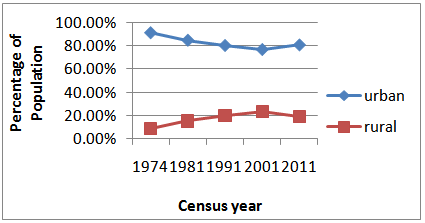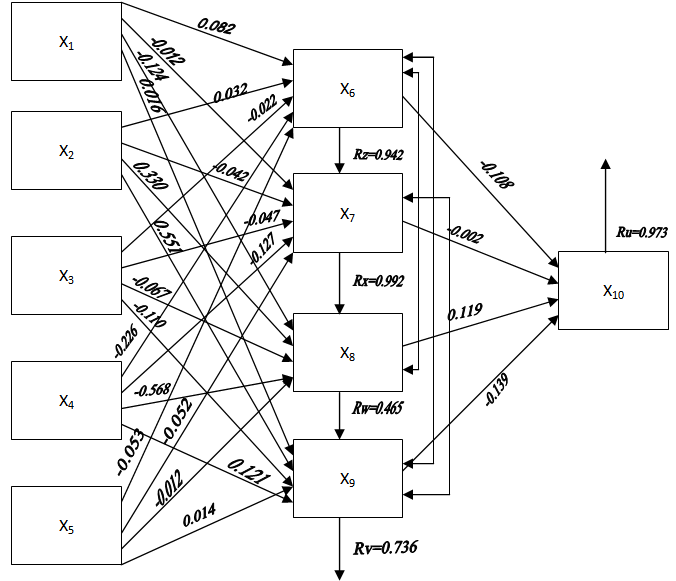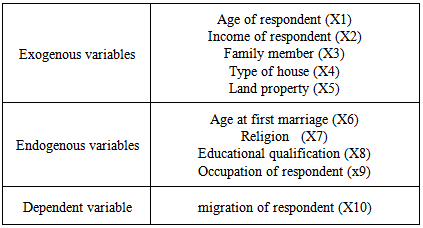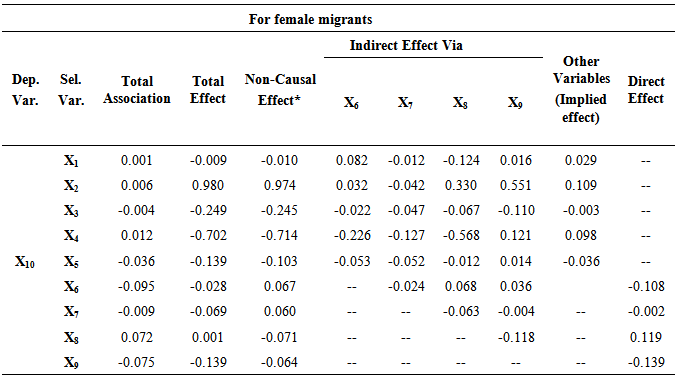-
Paper Information
- Previous Paper
- Paper Submission
-
Journal Information
- About This Journal
- Editorial Board
- Current Issue
- Archive
- Author Guidelines
- Contact Us
American Journal of Operational Research
p-ISSN: 2324-6537 e-ISSN: 2324-6545
2015; 5(1): 9-14
doi:10.5923/j.ajor.20150501.02
Effects of Socio-Demographic Factors on Female Migrants: Path Model Approach
Rafiqul Islam1, Abdur Rokib1, Rashed Alam1, Nazrul Islam Mondal1, Shafiur Rahman2
1Department of Population Science and Human, Resource Development, University of Rajshahi, Bangladesh
2Dpartment of Public Health, First Capital University of Bangladesh, Chuadanga, Bangladesh
Correspondence to: Rafiqul Islam, Department of Population Science and Human, Resource Development, University of Rajshahi, Bangladesh.
| Email: |  |
Copyright © 2015 Scientific & Academic Publishing. All Rights Reserved.
Migration is a process that occurs between two geographical places of population with high ambition and many objectives. Rural to urban migration is responsible for two-third of the increment of urban population annually in Bangladesh. The purpose of this study is to identify the direct and indirect effects of some selected socio-economic and demographic variables on female migrants. For this study, the data is collected using three-stage sampling technique from Meherpur Sadar Thana under Meherpur district, Bangladesh. To fulfill the objectives, path model analysis was to estimate the direct, indirect and joint contribution of socio-economic and demographic variables on females’ decision of migrantion. It is found that age at first marriage, religion and occupation of respondent have significant direct negative effects while educational qualification of respondent have direct positive effects on female migration.
Keywords: Migration, Socio-demographic variables, Female migrants, Path model analysis
Cite this paper: Rafiqul Islam, Abdur Rokib, Rashed Alam, Nazrul Islam Mondal, Shafiur Rahman, Effects of Socio-Demographic Factors on Female Migrants: Path Model Approach, American Journal of Operational Research, Vol. 5 No. 1, 2015, pp. 9-14. doi: 10.5923/j.ajor.20150501.02.
Article Outline
1. Introduction
- Bangladesh is one of the most densely populated countries in the world. The population of Bangladesh has increased from 42 million in 1941 to 139.25 million in 2011 (BBS, 2003; BBS, 2012) and it is expected to stabilize at around 240 to 250 million by the year from 2025 to 2030 (UNFPA, 1994). The population of Bangladesh is mostly poor and majority of them live in rural areas. The percentage of rural and urban population was 91.2% and 8.8% in 1974, 84.82% and 15.18% in 1981, 80.37% and 19.63% in 1991, 76.9% and 23.1% in 2001, and 80.80% and 19.20% in 2011 respectively (BBS, 2003 and 2012). Currently, the annual increment in urban population is 1.6-1.7 million, which is expected to rise to 1.9 million by the next few years of which two thirds of migration will be due to in-migration from rural areas (NIPORT, 2014). For the better understanding, percentages of population of urban and rural area of Bangladesh due to census years are shown in figure 1.
 | Figure 1. Percentage of population of urban and rural area of Bangladesh due to census years |
2. Sources of Data
- To fulfill the aforementioned objectives, data were collected from Meherpur district of Bangladesh. The total population of Meherpur district is 655392 with a population density of 872 per square kilometer. In this study, multistage sampling technique was adopted. Meherpur district was chosen as 1st stage and then, Meherpur Sadar Thana out of three Thana’s of Meherpur district was taken as second stage. Thereafter, seven wards, out of nine wards, of Meherpur Sadar Thana (Meherpur Paurashava) were chosen at the third stage. The total population under Meherpur Paurashava is 43133 of which 21349 are females (BBS, 2012). From each of the selected wards, data were collected from 100 females using interview method, which in total a size of 700. Seven data collectors were recruited and trained for data collection. Data collection took places between 5th January to 27th January, 2008.
3. Methodology
- Path model analysis was used as the statistical tool. It was developed by Alwin and Hauser (1975), is a standardized multiple regression analysis in which a chain of relationships among the variables, arranged in an orderly manner, is examined through a series of regression equations. It provides more information than the regression analysis in spite of the fact that it, by and large, uses almost same steps in estimating various coefficients. Alwin and Hauser method requires the following steps. For each endogenous variable in the model, obtain the successive reduced from equation. Firstly, regress the endogenous variables only on the exogenous variables. Then regress the endogenous variables on the exogenous variables and the intervening endogenous variables that come in sequence from cause to effect. While the first reduced form of equation of a particular endogenous variable gives the total effects, the last equation provides the direct effects. Successive deduction of path coefficients from first to second equation, from second to third equation and so on, indicates the indirect effects. Model specification of female migrants In the path model, the direct and indirect effects of variables are studied. It is not a method for discovering causes, but a method applies to a causal relation on the basis of prior knowledge and theoretical consideration. According to the causal ordering of variables, the set of selected variables are denoted into three groups (exogenous, endogenous and dependent) which are presented in Table 1. The given model is a recursive path model in which each variable is measured to be dependent upon all prior causal variables. Under additional assumption of linearity and additivity, the system of equations for the model can be written as followsX6 = P61X1 + P62X2 + P63X3 + P64X4 + P65X5 + P6uRu-X7 = P71X1 + P72X2 + P73X3 + P74X4 + P75X5 + P76X6 + P7vRvX8 = P81X1 + P82X2 + P83X3 + P84X4 + P85X5 + P86X6 + P87X7 + P8wRwX9 = P91X1+ P92X2 + P93X3 + P94X4 + P95X5 + P96X6 + P97X7 + P98X8 + P9xRxX10 = P101X1+ P102X2 + P103X3 + P104X4 + P105X5 + P106X6 + P107X7 + P108X8 + P109X9 + P10zRzWhere, Pji’s are path coefficients from Xi to Xj and Ru, Rv, Rw, Rx and Rz are random disturbance terms. These systems of equations are known as structural equations. These selected variables give the estimates of path coefficients and helps to understand the important relationship between various variables considered in the causal model. All the variables are transformed into normal forms by subtracting the respective means and dividing by the respective standard deviation. The regression coefficients thus obtained are the path coefficients.
|
4. Results and Discussions
- Table 2 presents the results of zero order correlation coefficients of various socio-economic and demographic variable considered in the present study. Path coefficients are shown in figure 2 and the different types of effects are presented in Table 3. Also Table 4 shows their percentage value. In path analysis, path coefficients of direct, indirect and implied effect of the selected explanatory variables are obtained. From Table 2 it is observed that four variables are statistically significant out of ten variables.
|
|
|
 | Figure 2. Interrelationship between various socio-economic and demographic variables of the migration |
5. Conclusions
- A well-known multivariate technique named path model analysis suggest that educational qualification of female migrants have direct significant positive effects and age at first marriage have direct negative effects on migration. Because education may provide better employment opportunities outside home and age at first marriage can be raised through providing education. And the tendency of migration flow can be reduced at the increasing of age at first marriage. Thus, suitable strategy should be adopted to increase age at first marriage for under developed and developing countries for reducing their migration flows.
 Abstract
Abstract Reference
Reference Full-Text PDF
Full-Text PDF Full-text HTML
Full-text HTML


